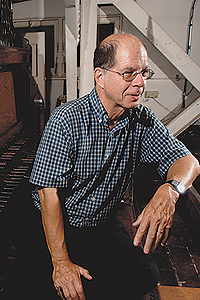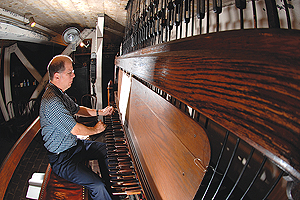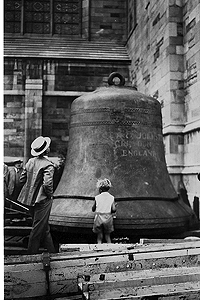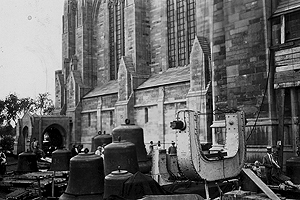Now and then, and again: Once restored, carillon’s bells will ring true as they did in 1932
By Josh SchonwaldNews Office
  Wylie Crawford, Carillonneur for the University (top) since the 1970s, sits at the console of the carillon. Above, some of the bells, which will be restored, ring as Crawford plays the massive instrument (below). When the bells of the carillon are returned after their restoration, their reinstallation will likely create a scene much like the one in 1932, when the carillon was first installed in Rockefeller Memorial Chapel (see black-and-white photos below).    | |
For its 75th birthday, the world’s second largest carillon will get a huge gift—a much-needed restoration.
Later this month, a team of carillon restoration experts from the Royal Eijsbouts foundry in The Netherlands—there are only a half-dozen or so firms in the world that specialize in the field—will climb the Rockefeller Chapel tower and begin the process of dismantling the 58 upper bells of the 100-ton Laura Spelman Rockefeller Carillon and taking them to local storage.
“I’m ecstatic,” said Wylie Crawford, the University Carillonneur, of the impending restoration. “It’s long overdue.”
Although carillon bells are designed to last for centuries, and many European carillons date back 400 years or more, the playing mechanism in the famous carillon has deteriorated over the years.
Crawford, who has worked as Carillonneur for the University since the early 1970s, said that problems have been especially noticeable in the third octave. “That’s a very busy octave,” said Crawford. The iron clappers, which strike the bell, have become flattened, he said, “They’re not hitting the right strike point.”
Not only will the Dutch firm replace the clappers, but also they will use a new design and better materials. It will make the carillon a more responsive instrument, Crawford said, by improving the connection between the keyboard and the bells.
In addition to the clapper restoration, the carillon’s playing console will be modified, the lower bell frame will be cleaned and repainted, the playing cabin will be replaced and a new upper bell frame will be constructed above the new cabin.
The University’s Facility services will replace the playing cabin.
Crawford expects the bells to return in time for a gala concert and celebration in June 2008. In the meantime, even though the upper bells will be absent, the 14 big bells will be present. So rest assured, Crawford noted, “You’ll still hear the hour strike.”
The carillon restoration is part of a larger, multi-year chapel renovation project, which has included the addition of the Interreligious Center in the chapel basement, and restoration of the organ and the building’s exterior. “With the scaffolding already up to restore the buildings exterior,” Crawford said, “It made sense to renovate the carillon now. Scaffolding itself is very expensive.”
Funding for the carillon project, in large part, came from donors who gave the carillon restoration as a birthday gift to Don Randel, President Emeritus and a well-known carillon music fan.
Built in 1932 in remembrance of John D. Rockefeller Jr.’s mother, Laura Spelman Rockefeller, the carillon was named for her and presented as a gift to the University. Housed in the chapel tower, it is the second-largest carillon in the world, with 72 bells ranging from 10.5 pounds to 18.5 tons. The great bourdon, or bass bell, boasts a diameter of nearly 10 feet.
The art of carillon playing originated nearly 500 years ago in an area of Europe that now is composed of the Netherlands, Belgium and northern France. Unlike many other bells, carillon bells remain fixed while they are played. The clappers move instead, connected by wires and a tracker system to a playing console that controls both rhythm and dynamics. The console consists of a double row of oak keys and a pedal board, which the carillonneur plays using the fists and feet.
![[Chronicle]](/images/sidebar_header_oct06.gif)